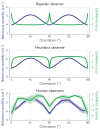Dual strategies in human confidence judgments
- PMID: 34010953
- PMCID: PMC8142718
- DOI: 10.1167/jov.21.5.21
Dual strategies in human confidence judgments
Abstract
Although confidence is commonly believed to be an essential element in decision-making, it remains unclear what gives rise to one's sense of confidence. Recent Bayesian theories propose that confidence is computed, in part, from the degree of uncertainty in sensory evidence. Alternatively, observers can use physical properties of the stimulus as a heuristic to confidence. In the current study, we developed ideal observer models for either hypothesis and compared their predictions against human data obtained from psychophysical experiments. Participants reported the orientation of a stimulus, and their confidence in this estimate, under varying levels of internal and external noise. As predicted by the Bayesian model, we found a consistent link between confidence and behavioral variability for a given stimulus orientation. Confidence was higher when orientation estimates were more precise, for both internal and external sources of noise. However, we observed the inverse pattern when comparing between stimulus orientations: although observers gave more precise orientation estimates for cardinal orientations (a phenomenon known as the oblique effect), they were more confident about oblique orientations. We show that these results are well explained by a strategy to confidence that is based on the perceived amount of noise in the stimulus. Altogether, our results suggest that confidence is not always computed from the degree of uncertainty in one's perceptual evidence but can instead be based on visual cues that function as simple Heuristics to confidence.
Figures





References
Publication types
MeSH terms
Grants and funding
LinkOut - more resources
Full Text Sources
Other Literature Sources
Research Materials

